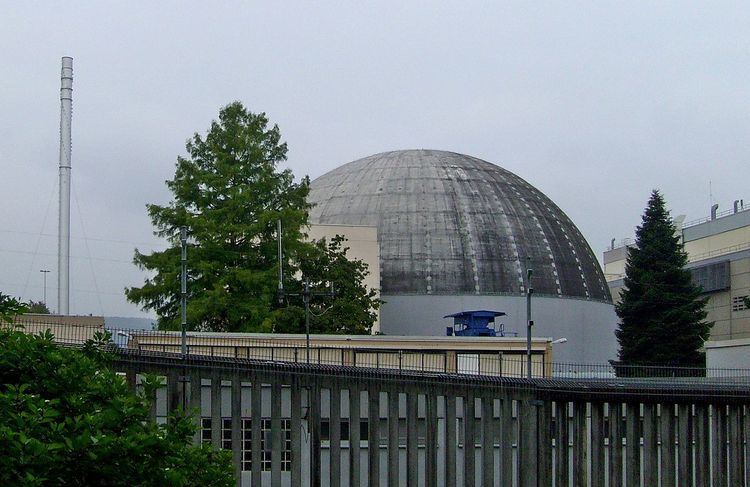Country Germany Reactor type PWR Decommission date 11 May 2005 | Status Mothballed Construction began 1965 | |
 | ||
Location Obrigheim, Neckar-Odenwald-Kreis | ||
The Obrigheim Nuclear Power Plant (KWO) is a mothballed nuclear power plant in Obrigheim, Neckar-Odenwald-Kreis, at the river Neckar, owned by EnBW, and operated one pressurized water reactor unit from 1969-2005. It has been defuelled since 2007 with spent fuel rods awaiting transport to an interim storage facility. In March 2017, EnBW tested to ship numerous castors by barge on the Neckar to the Neckarwestheim Nuclear Power Plant 40 km downstream.
Contents
History 1959-2005
On May 5, 1955 the Federal Republic of Germany, with the French occupation force, started to work seriously towards peaceful use of nuclear energy. The district of Bavaria and Baden-Württemberg were particularly interested in this development. In 1957 the Arbeitsgemeinschaft Kernkraft Stuttgart (AKS) group had already been created in Baden-Württemberg. The minister-president and minister of economics of Baden-Württemberg at the time, Hermann Veit took over the project of establishing a nuclear power plant, and looked towards the Calder Hall Gas cooled reactor in England for a design.
In the spring 1959, AKS chose an unusual reactor design, the organically moderated and cooled reactor (OMR). When the much smaller AEC demonstration facility at Piqua, Ohio reported severe problems, they switched to a light water reactor in 1962.
The reactor went online in 1969 and was shut down in 2005.
Decomissioning, 2005-present
Since 2005 the EnBW owned nuclear power in Obrigheim has been in the process of dismantlement; the spent fuel rods have been in wet storage since 2007. The salient barrier is a missing final repository for the 342 highly radioactive fuel rods. Obrigheim does not have an interim storage facility. For EnBW not to have to build one, the fuel rods need to be shipped to the Neckarwestheim Nuclear Power Plant, which is about 40 kilometers away and still has space in its temporary storage. The move has already been approved, but it is still unclear by what means. EnBW has considered transport by road, by rail and by barge. The former 2 options do not apply absent a nearby train connection, and road transport is complicated by single lane roads through a densely populated area, where large-scale barriers would have to be made.
Since both nuclear plants were built on the banks of the Neckar, barge transport appears to be the preferred way in spite of the 23 bridges and 6 locks it must pass. A ramp has already been built in Obrigheim. To test the process, EnBW had shipped empty nuclear waste containers over the Neckar in early March 2017. Even the green environment ministry in Baden-Württemberg thinks the waterway is the best solution, but the Bundesministerium für Umwelt approval is yet to come. For the first time in Germany´s history, highly radioactive waste would be transported on a river.
Protest against the castor transports on the river has been building. About 650 people followed a call for the "Neckar castorfrei" campaign to protest and march as "a sign before the anniversary of the Fukushima disaster of March 11, 2011".
Hardware features
The electric power was transported by a single powerline to Hüffenhardt substation. The powerline carried 4 circuits, 2 for 220 kV and 2 for 110 kV. The circuits for 110 kV were mounted on the lowest of the three crossbars of the pylons, and the circuits for 220 kV on the middle and the upper crossbar of the pylons.
An unusual feature of the powerline between the pylons is that insulators are mounted between the conductors to prevent short circuits by too close a conductor clearance with strong winds.
For radioactivity monitoring there were two meteorological towers, both built as lattice steel mast. One of them was built in 1977/78 between the village of Asbach and Kirstätter Hof at 49 20 30 N and 9 02 47 E. In 2001, the 169 metres tall mast was demolished by explosives and a free-standing mobile phone transmission tower consisting of prefabricated concrete was built on its site. The other meteorological tower erected in 1962 is 99 metres tall, located close to the power plant, and still in use.
